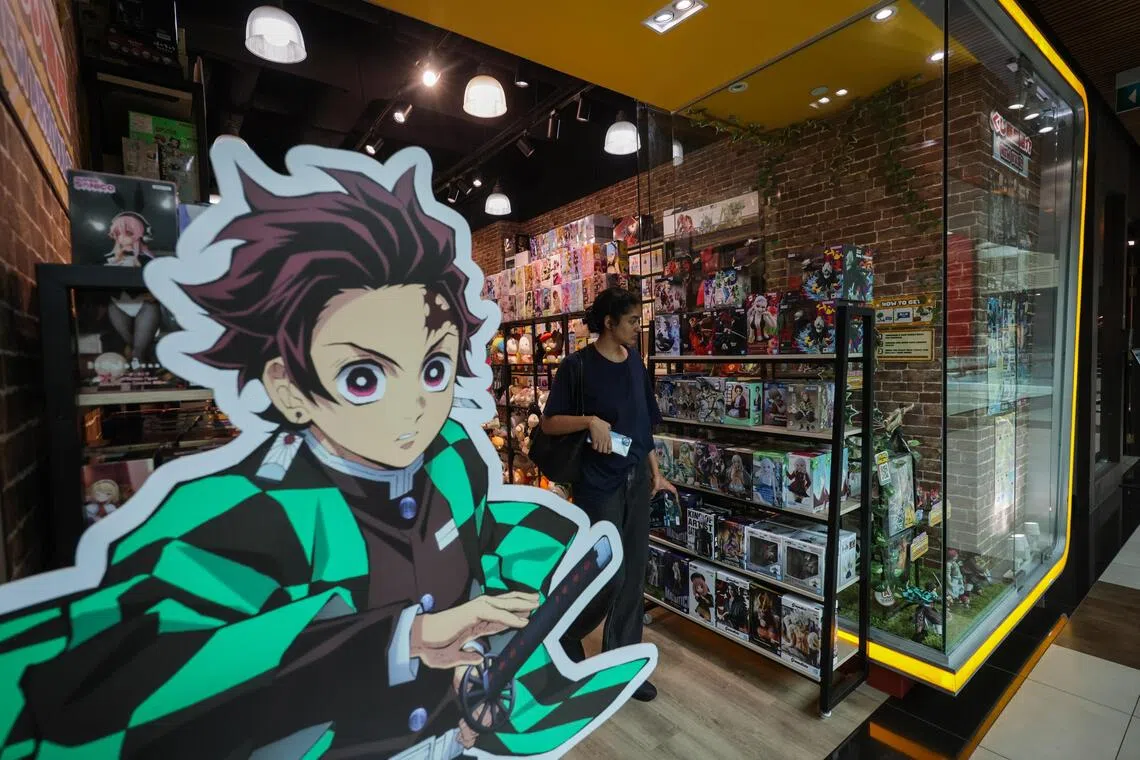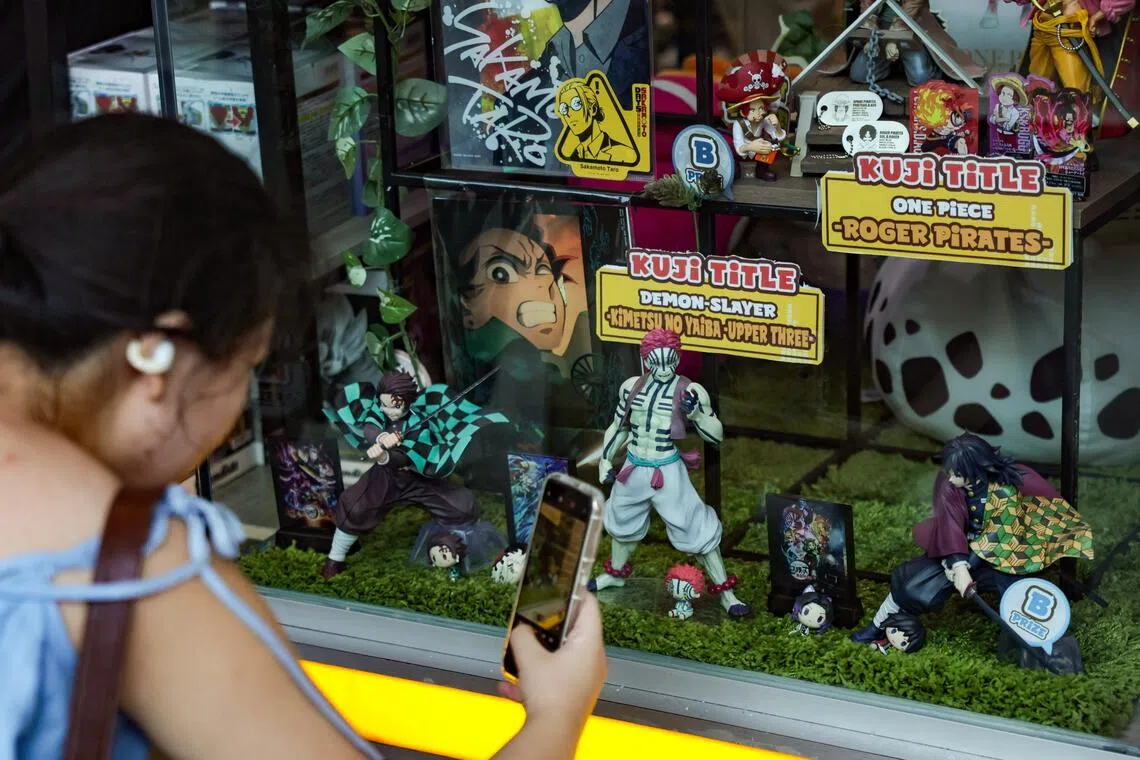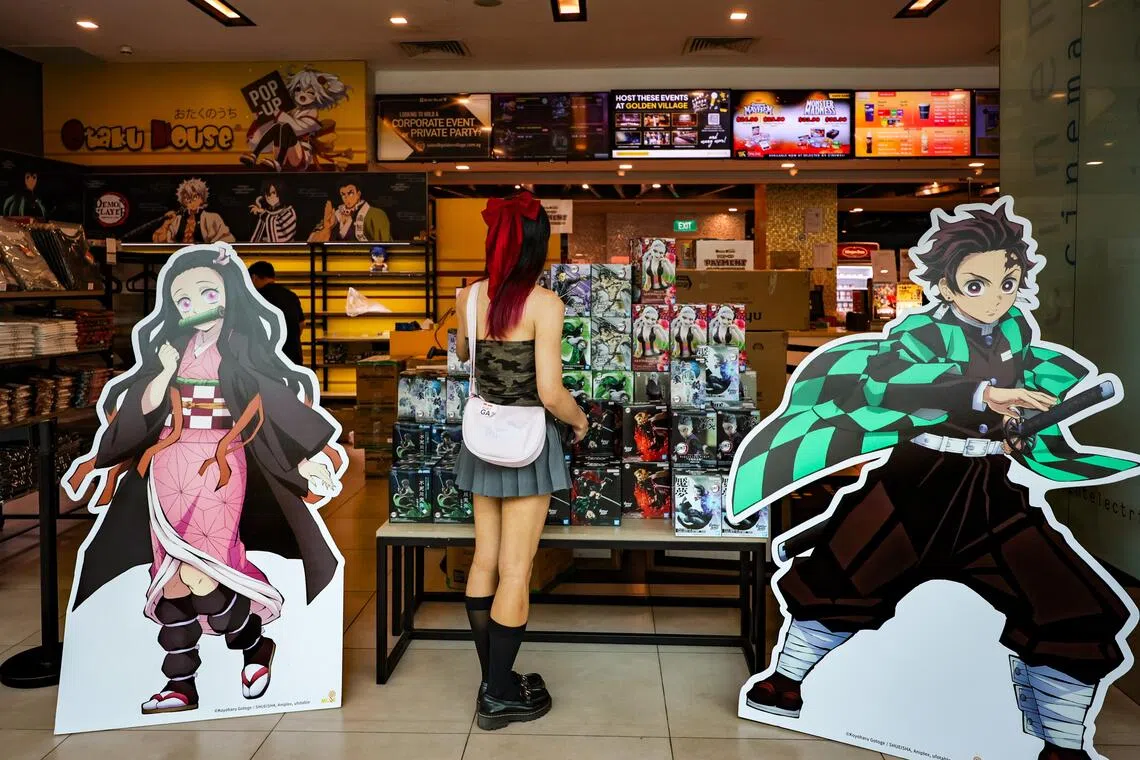‘Even my mum knows about Demon Slayer’: How anime went from ‘cringey’ to mainstream in Singapore
Sign up now: Get tips on how to grow your career and money

Businesses have noticed increases in sales of anime-related merchandise in recent years, while more people are flocking to anime-related events.
ST PHOTO: GIN TAY
Follow topic:
SINGAPORE – Being an anime fan used to be uncool, according to Ms Sheila Tan, who has been a fan of the genre since she was nine.
But lately, the 25-year-old wedding planner, who goes by Koala Tea when cosplaying, has been noticing more and more people attending big anime conventions here, such as the annual Anime Festival Asia (AFA) Singapore.
AFA debuted in 2008 in Singapore, and the 2025 edition will be held at Suntec Singapore Convention & Exhibition Centre from Nov 28 to 30.
“The crowd is around 30 per cent bigger now compared with pre-pandemic levels,” she said. “There was a stigma where if you liked anime, you were seen as ‘cringe’. It definitely still exists, but there’s less of it now.
“Even my mum knows about Demon Slayer,” she added, referring to the hit anime franchise that has made waves globally.
Once considered by some to be a subculture of popular media, anime has recently stolen the limelight in mainstream entertainment.
Demon Slayer: Kimetsu No Yaiba – Infinity Castle (2025), which is showing in Singapore cinemas, became the first Japanese anime film to pass US$600 million (S$772.4 million) at the worldwide box office as at Sept 29, according to Sony Pictures Entertainment, which distributed the movie internationally. Its tally now stands at over US$633 million, beating the US$513 million of the first movie Demon Slayer: Kimetsu No Yaiba Mugen Train (2020).
The historical fantasy is set in Japan and follows an adolescent boy’s search for a cure for his sister, who has turned into a demon.
In contrast, 2025’s superhero blockbusters like Marvel’s The Fantastic Four: First Steps and DC’s Superman have grossed over US$521 million and US$615 million respectively worldwide.
Popularity spike
Anime has been increasing in popularity over the last 10 to 15 years, with a spike after the Covid-19 pandemic, observers told The Straits Times.
Programmes of the genre were viewed more than one billion times on Netflix in 2024, with viewership tripling over the last five years, the streaming service said. Thirty-three anime titles appeared in its Global Top 10 (Non-English) lists that year – more than double the number of titles from 2021. The list is updated every week.
Businesses selling anime-related products that ST approached have noticed increases in their sales in recent years, while more and more people are flocking to anime-related events.

Figurines of main characters are the most popular among buyers, says retailer Otaku House.
ST PHOTO: GIN TAY
One retailer, toy store La Tendo in Suntec City shopping mall, sold five or six times as much anime-related merchandise as it usually does after the latest Demon Slayer film opened here in August.
Founder Reedy Tay said the store used to sell mainly action figures, model kits and soft vinyl figures when it opened about 20 years ago, but has expanded to keychains, T-shirts and stuffed toys in the last 15 years to appeal to the growing number of female customers.
Its clientele has also evolved – from more than 90 per cent being men in their early 20s to 30s, to an almost even split between men and women across different ages.

The Demon Slayer series is set in Japan and follows an adolescent boy’s search for a cure for his sister, who has turned into a demon.
ST PHOTO: GIN TAY
Cinema chain Shaw Theatres said its anime releases were “relatively ad hoc and sporadic pre-Covid”, with none in 2019. But it screened six anime films in 2023 and 11 in 2024. It is slated to show seven by the end of 2025 to cater to the preferences of Singapore audiences.
The number of anime movies shown on Shaw’s Imax theatre screens has grown year on year since the pandemic, with one screening in 2023, two in 2024 and an expected five in 2025.
Its August fan screening of Infinity Castle – which saw attendees taking home goodie bags of collectible trading cards, holographic posters and acrylic display standees of characters – sold out within 15 minutes, despite its $65 ticket. Movie ticket prices typically range from $11 to $25.
In 2019, the annual AFA – which usually features J-pop concerts, well-known cosplayers and meet-and-greet sessions with Japanese voice actors, producers and singers – drew about 123,000 people. But from 2022 to 2024, it attracted between 127,000 and 145,000 visitors to each edition.
The Singapore Tourism Board said there has been a significant rise in new visitors to the event since 2022. The 2022 event had a record of over 145,000 attendees, with more than 30 per cent of them experiencing it for the first time.
Another sign of growth? The three-day Hoyo Fest, an annual fan festival for games developed by Chinese video game company Mihoyo, was ticketed for the first time in July in Suntec City, but still sold out its more than 6,000 tickets
Cosplayer Janice, 36, who declined to give their surname and goes by the username milodrumscraft on Instagram, said: “Before Covid, there was one cosplay event every two months. Now, there are cosplay or artist alley events every week.” Artists alleys are events where artists can sell or showcase their merchandise to fans.
Anime becomes more accessible
Observers have attributed the genre’s rising popularity to improved access to subtitled shows; the increased spending power of a maturing and expanding fan base, coupled with increased investment by related businesses; and the growth of online fan communities, among other factors.
Previously, translated anime titles might reach Singapore audiences months or years after their release in Japan, said Associate Professor Deborah Shamoon, who specialises in Japanese studies at National University of Singapore (NUS).
It is much faster now. Netflix said the latest anime titles, such as The Summer Hikaru Died (2025), are launched worldwide simultaneously and dubbed in up to 33 languages, with more than 50 per cent of global Netflix members watching anime.
Netflix reported ending the 2024 financial year with 302 million paid subscribers.
Lecturer Joel Gn, who specialises in product design at Lasalle College of the Arts, said the relationship between anime fans and related businesses, such as streaming platforms, is cyclical.
Increased viewership of anime has led to companies offering more content and merchandise which, in turn, encourages more consumption.
“Yesterday’s youth are today’s adults. The working-adult population is able and willing to spend on anime or manga if and when it wants to,” said Dr Gn, who is also a fan and has attended anime conventions at home and abroad.
The internet has also accelerated the growth of the anime fandom, he said.
He added that online communities have helped anime and manga content go viral. They have also allowed fans to share anime recommendations, fan art and viral clips from the shows. Producers and creators can also gather feedback from fans in these communities.
Checks by ST showed that popular social networking sites for anime fans, such as MyAnimeList and the anime page on Reddit, were launched only in 2004 and 2008 respectively, although anime such as Doraemon have been around since the 1980s.
According to MyAnimeList’s advertising site, it has more than 150 million page views and 12 million unique visitors each month. The Reddit page has more than 14 million members.
NUS’ Dr Shamoon said part of the attraction of anime is that some titles would incorporate “big philosophical and existential topics, conflicted heroes and nuanced stories”, citing the work of Japanese film-maker Makoto Shinkai.
She also pointed to merchandise as a key aspect of the popularity of some titles.
“The availability of merchandise at mainstream retailers such as Uniqlo makes it easy to acquire, and the more people wear the T-shirt, the more normalised the fandom becomes,” she said.
But the increased interest in anime comes with its own challenges.
Ms Ivy Li, who has been a fan for more than three decades, said the mainstream popularity of anime has attracted an influx of what some call “anime tourists”.
“They are usually people who criticise anime on a surface level, without spending time to understand or finish watching the show. Their superficial critiques can be disrespectful to the history of anime and they just want to criticise the shows for clout,” said the 44-year-old, who uses anime as part of her work at mental health service provider Grip Connect.
Also, cosplayer Koala Tea said newcomers to the scene sometimes do not know how to behave properly at cosplay events. For example, people should always ask before taking pictures of cosplayers, instead of treating them like exhibits.
One should not invade cosplayers’ personal space to pose for pictures, she said. “Even though we are all fans, boundaries must still be respected.”
Book it/Anime Festival Asia Singapore 2025
Where: Suntec Singapore Convention & Exhibition Centre, 1 Raffles Boulevard ticketmaster.sg animefestival.asia
When: Nov 28 to 30, from 10am
Admission: From $22 via Ticketmaster (go to
Info:

